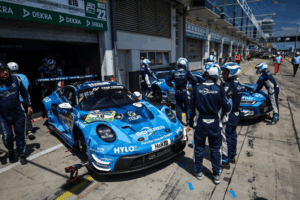As part of the Cultural Week of Cogolludo, a conference was held on August 11 in the plenary hall of the municipality, on the occasion of the centenary of the devastating fire that destroyed the Military Engineers’ Academy of Guadalajara on the night of February 9th to 10th, 1924.
Javier Segura, official tour guide, was in charge of leading this conference, before a large audience. Segura began his presentation by reviewing the history of the military engineers corps, from its origins in the time of Philip II with the Mathematics and Fortification Academy of Madrid, to the creation of academies in various locations, such as Cartagena de Indias, Barcelona, Alcalá de Henares, and finally, Guadalajara in 1833.
The speaker highlighted the historical significance of the place where the Academy stood, which in other times were the houses of Iñigo López de Orozco and the Montesclaros Palace, converted into the Cloth Factory until its closure in 1822. During his presentation, Segura showed newspaper clippings from the time that reported on the fire and the promises of reconstruction that were never fulfilled by figures such as King Alfonso XIII, General Primo de Rivera, and General Tejera, in charge of the Engineers Section at the Ministry of War.
The fire, which started in the detention room, quickly worsened and destroyed valuable volumes from the library, roofs, and other essential elements of the Academy. Segura explained how assistance was requested from the Carabanchel fire station and how, ultimately, 20 firefighters arrived to combat the flames, using over 700,000 liters of water. Despite their efforts, the Academy was left in ruins with only the main facade and the tower with its clock standing, which had to be demolished for safety.
Among the few elements saved from the fire were 31 portraits out of a total of 104 that decorated the Portrait Hall. The loss also included key facilities such as the drawing room, the gymnasium, laboratories, and many other essential spaces for the training of engineers.
The Military Engineers’ Academy of Guadalajara was a training ground for notable figures in Spanish history, such as Pedro Vives Vich, a pioneer in Spanish aviation, and Emilio Herrera Linares, president of the Republic in exile and creator of the prototype of the spacesuit. It also trained Alfredo Kindelán, founder of the Air Force, and Alejandro Goicoechea, designer of the TALGO train.
Another prominent graduate was Captain Mariano Barberán, who in 1932 made one of the first transatlantic flights from Seville to Cuba in the “Cuatro Vientos” plane, marking a milestone in Spanish aviation before disappearing on his trip to Mexico.
The conference concluded with an emotional video that showed the facilities that existed in the Academy and ended with strong applause, highlighting the significant contribution of the city of Guadalajara to the history of Spain.
Referrer: MiMub in Spanish












